Renault was a great rival of Ferrari in the turbo era of F1. Mythical battles remained in our memory.
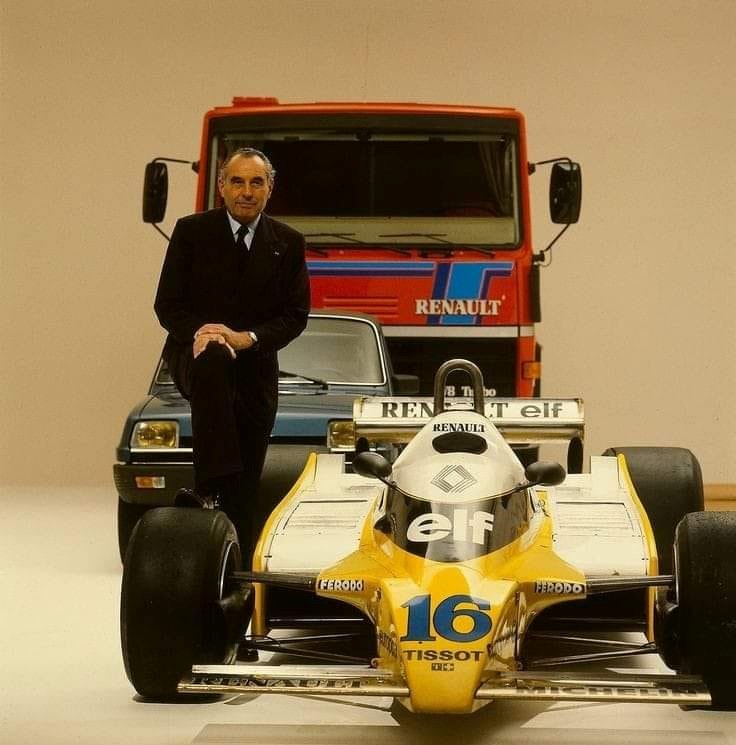
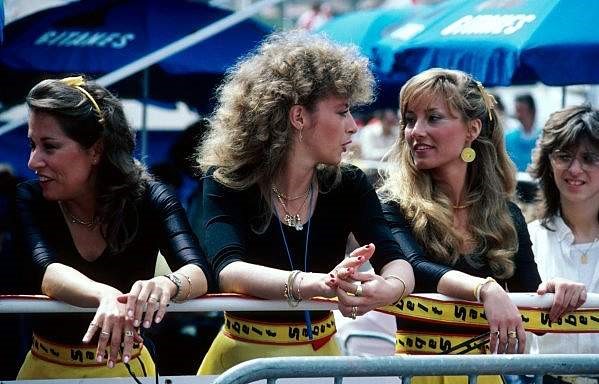
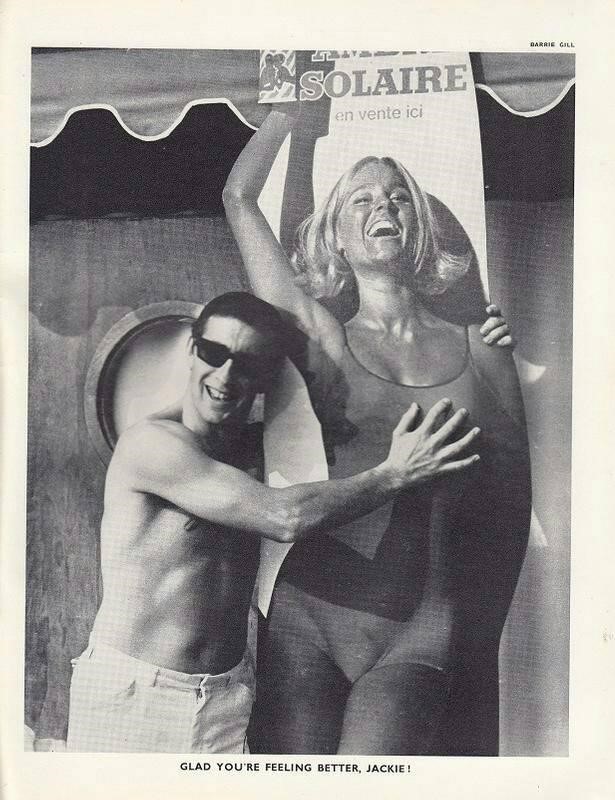
That’s why it should be considered an historical opponent and a protagonist of the romantic Formula 1, that of Villeneuve and Arnoux.
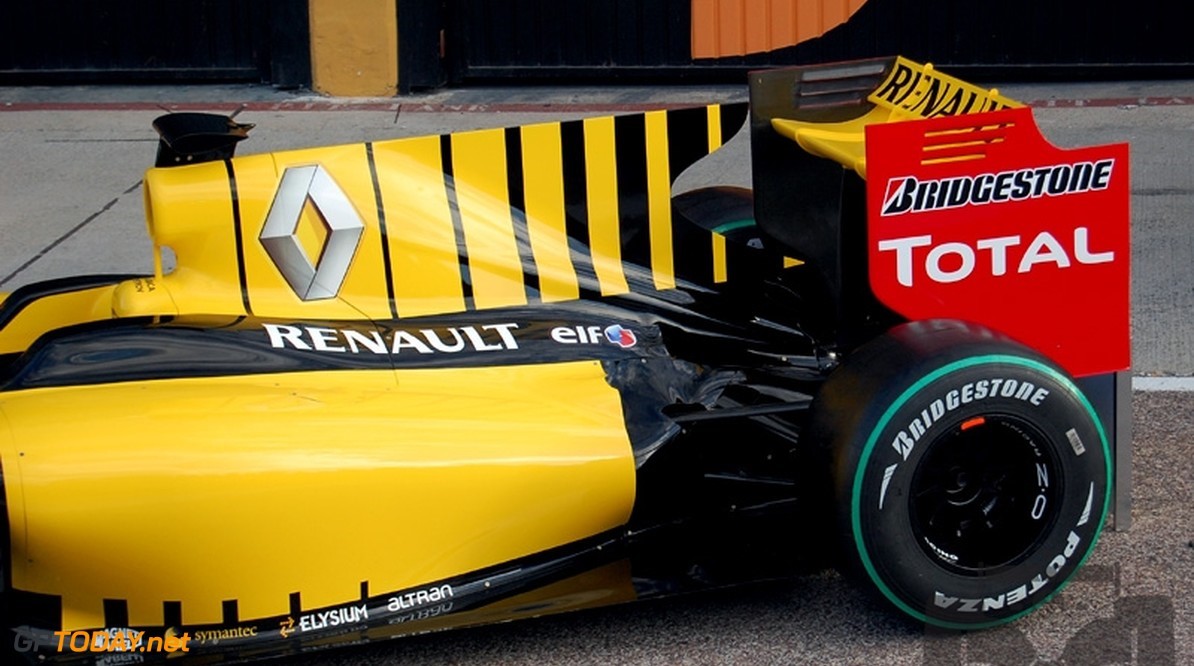
History: Renault in Formula 1. Published on 01 Dec 2015. By Calle Nilsson.
French car manufacturer Renault has been in Formula 1 for a long time and they have entered the sport as full works team just as often as they have supplied other teams. Renault is arguably one of the most successful Formula 1 entrants to date, as they have won 168 grand prix as an engine manufacturer, more than any other manufacturer apart from Ferrari (225) and Ford (176).

Renault has introduced several innovative technologies to Formula 1: they were the first manufacturer to use turbocharged engines and titanium gearboxes. Apart from the works Renault teams, notable teams Renault has supplied with engines in the past are Williams, Tyrrell, Lotus and Ligier. Renault currently supply Red Bull and Toro Rosso. Renault's future in F1 is uncertain and next year could see them enter as a full works team with Lotus or leave the sport altogether.
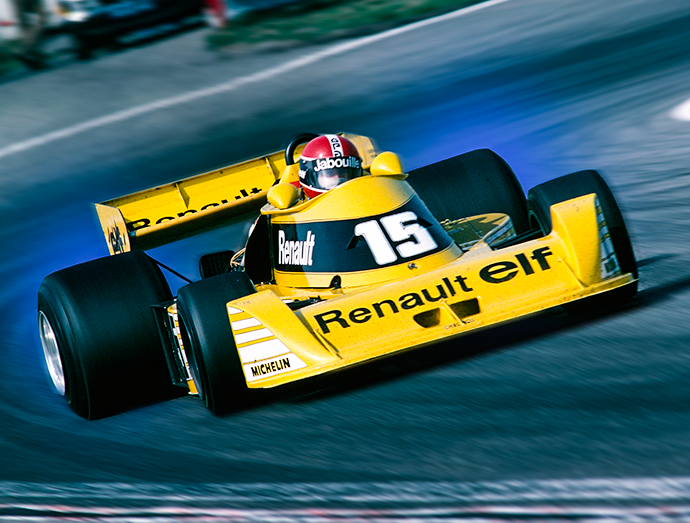
Renault F1 first saw the light of day in 1977, when Renault's sport division decided to enter only one car driven by Jean-Pierre Jabouille.
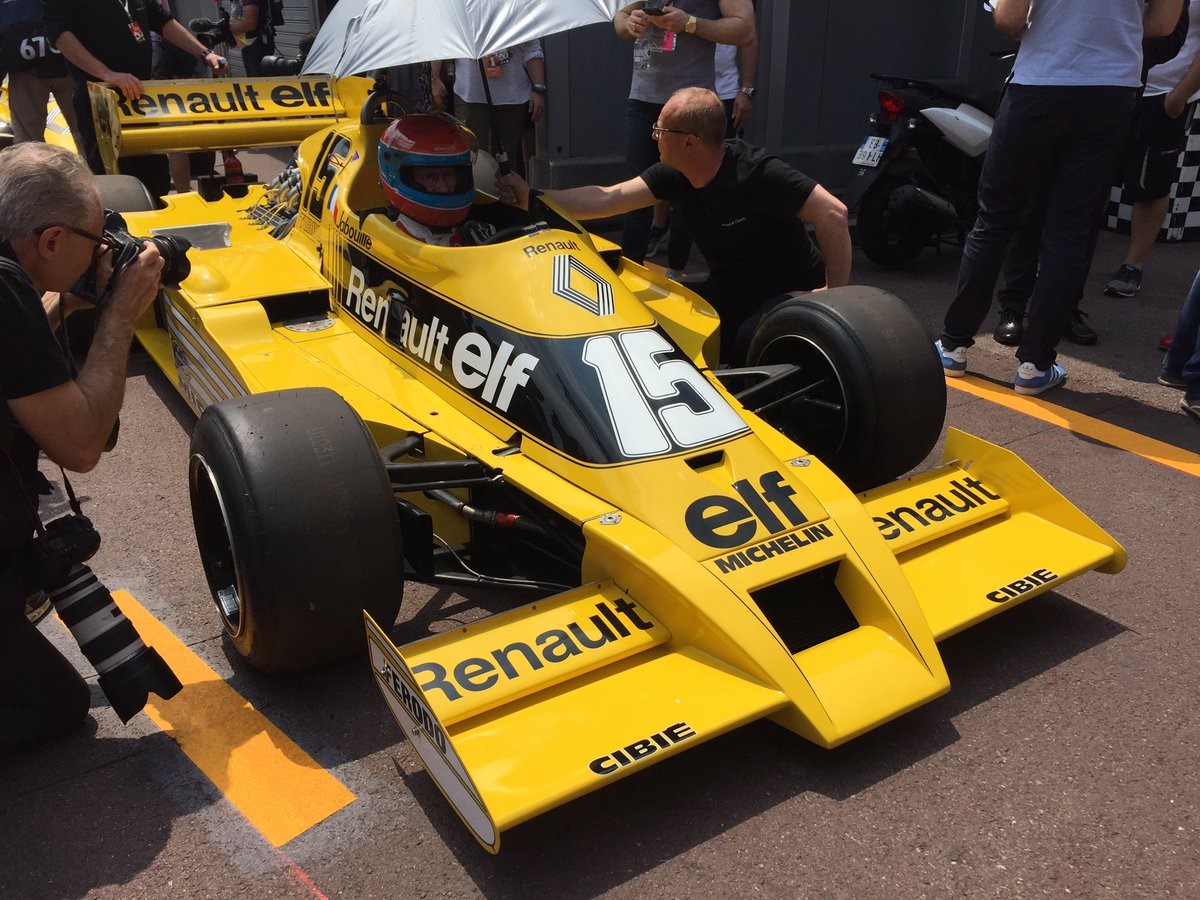
Celebrating 40 years of Renault in F1 at the Monaco GP. Jean-Pierre Jabouille in the '77 RS01.
The car, named the RS01, was the first F1 car to be powered by a turbocharged engine. While the engine was very powerful, it was also very unreliable, as was the rest of the car and it hardly managed to finish a single race in it's maiden year. Renault's bet performance in 1977 was at the Dutch grand prix, held at Zandvoort, where Jabouille qualified in 10th and ran for 6th place until the car's suspension failed and Jabouille had to retire.
While the car still lacked reliability in the following year, the team did improve somewhat and Jabouille managing to grab 3rd place twice in qualifying, claimed Renault's first F1 race finish in Monaco and even managed to score Renault's first points in a race, landing a 4th place in the United States grand prix held at Watkin's Glen. In 1979, Jabouille was joined by Renault's second driver, René Arnoux, who had raced in Formula 2 for Renault's longstanding partner, Oil company Elf. Using the new RS10 with it's ground effect system, the two French drivers qualified in 1st and 2nd place at the French grand prix and Jabouille managed to win the race, while Arnoux finished 3rd, only slightly behind Gilles Villeneuve. Arnoux would proceed to finish 2nd at Silverstone and at Watkin's Glen.
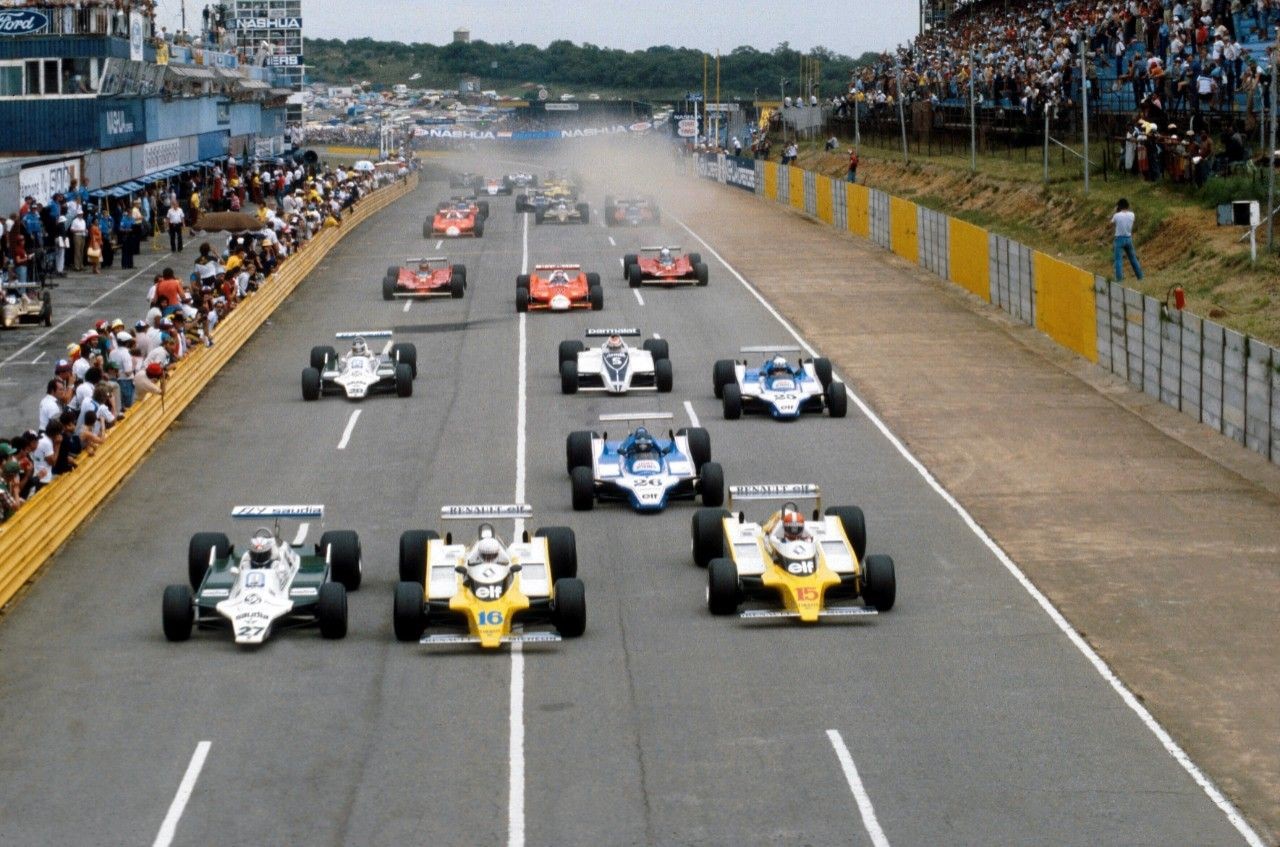
Start Formula 1 at Kyalami, March 1980.
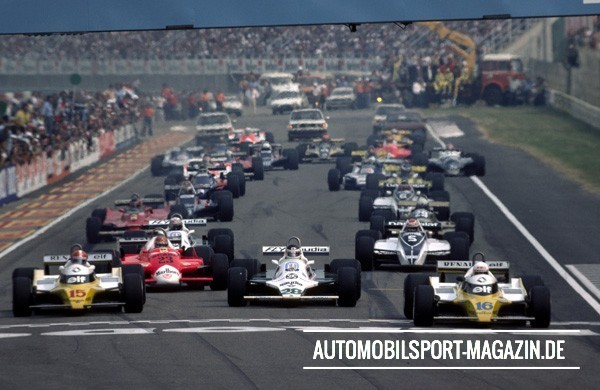
In the first years of the 1980s, Renault recieved mixed results.
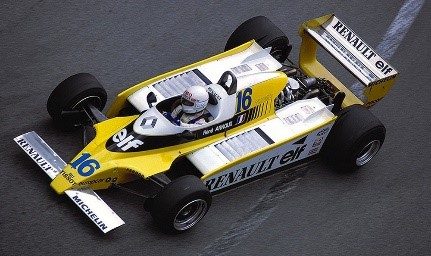
Renault-F1-1980.
Arnoux would claim a total of four victories in 1980 and 1982, while Jabouille remained plagued by retirements and he crashed heavily at Canada's GP.

Jean Pierre Jabouille, Renault RE 20, Grand Prix of Austria on 17 August 1980. Photo by Bernard Cahier - Getty images.
Jabouille's legs were gravely injured and he would never race in F1 again after the incident.
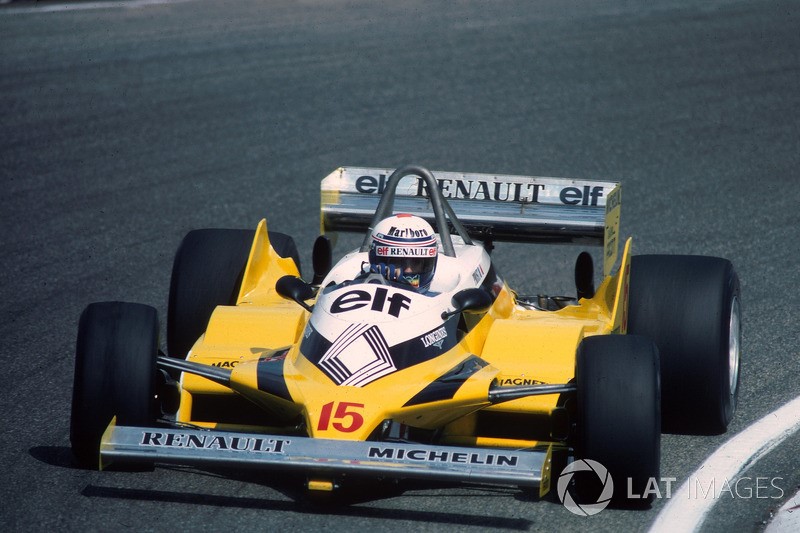
F1 Dutch Grand Prix 1981. Alain Prost, Renault RE 30.
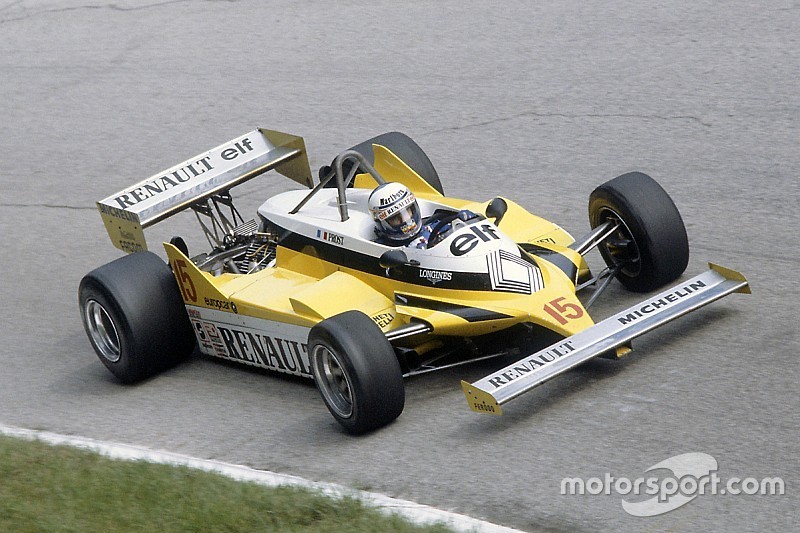
Formula 1 Italian GP 1981, Alain Prost in action.
Jabouille was replaced by Alain Prost.
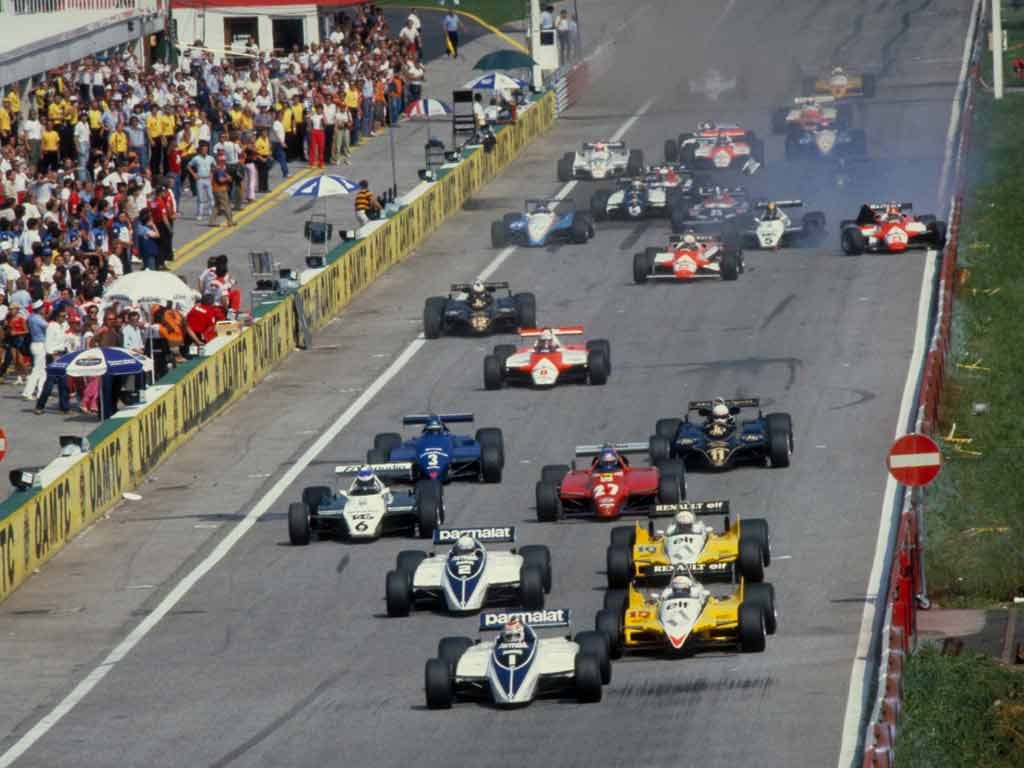
1982.
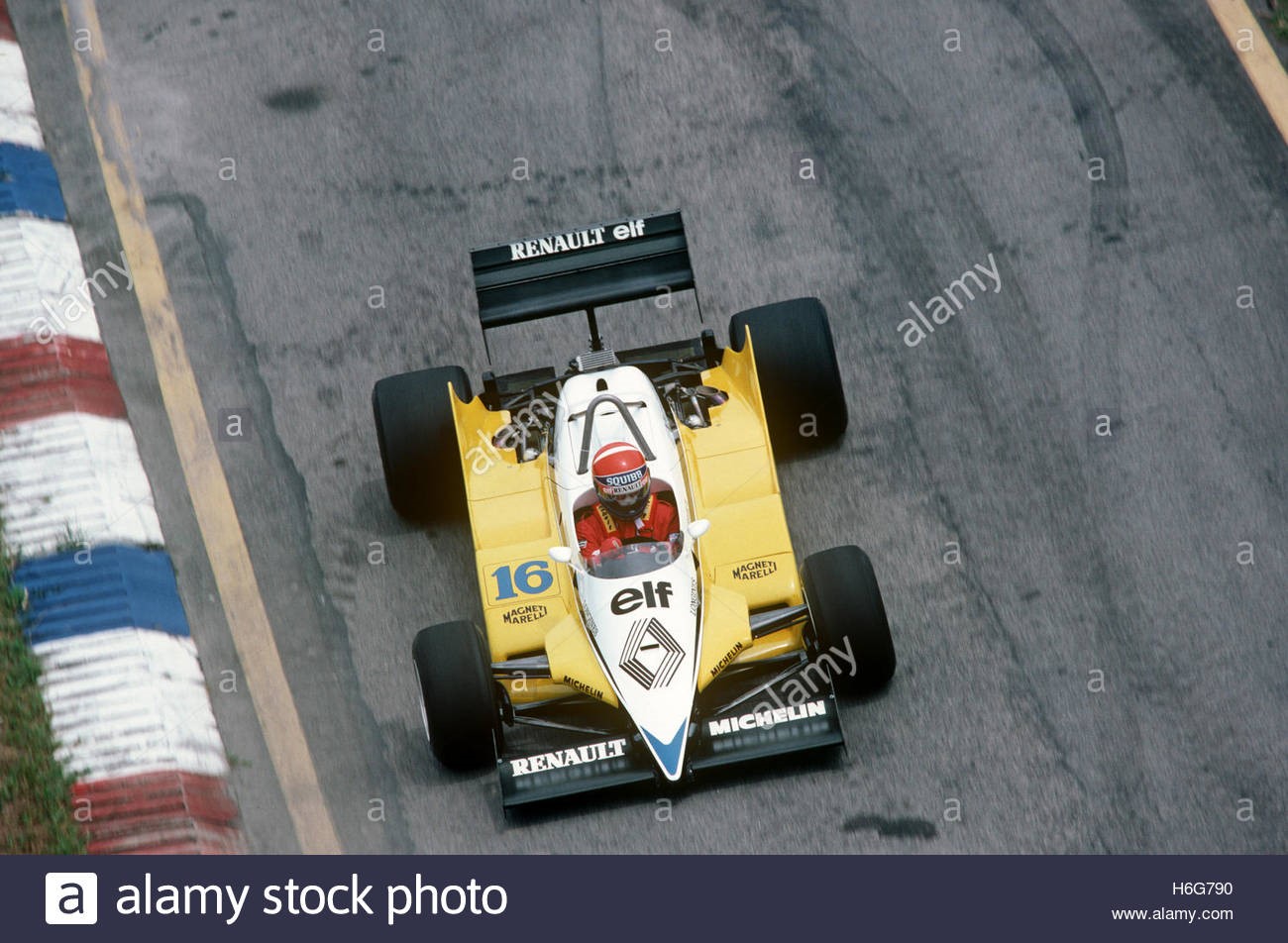
Rene Arnoux, Renault, at Long Beach GP in 1982.
1983 was Renault's best season so far and Prost scored 9 victories, one 2nd place and two 3rd places and finished as runner up behind Brabham's Nelson Piquet.
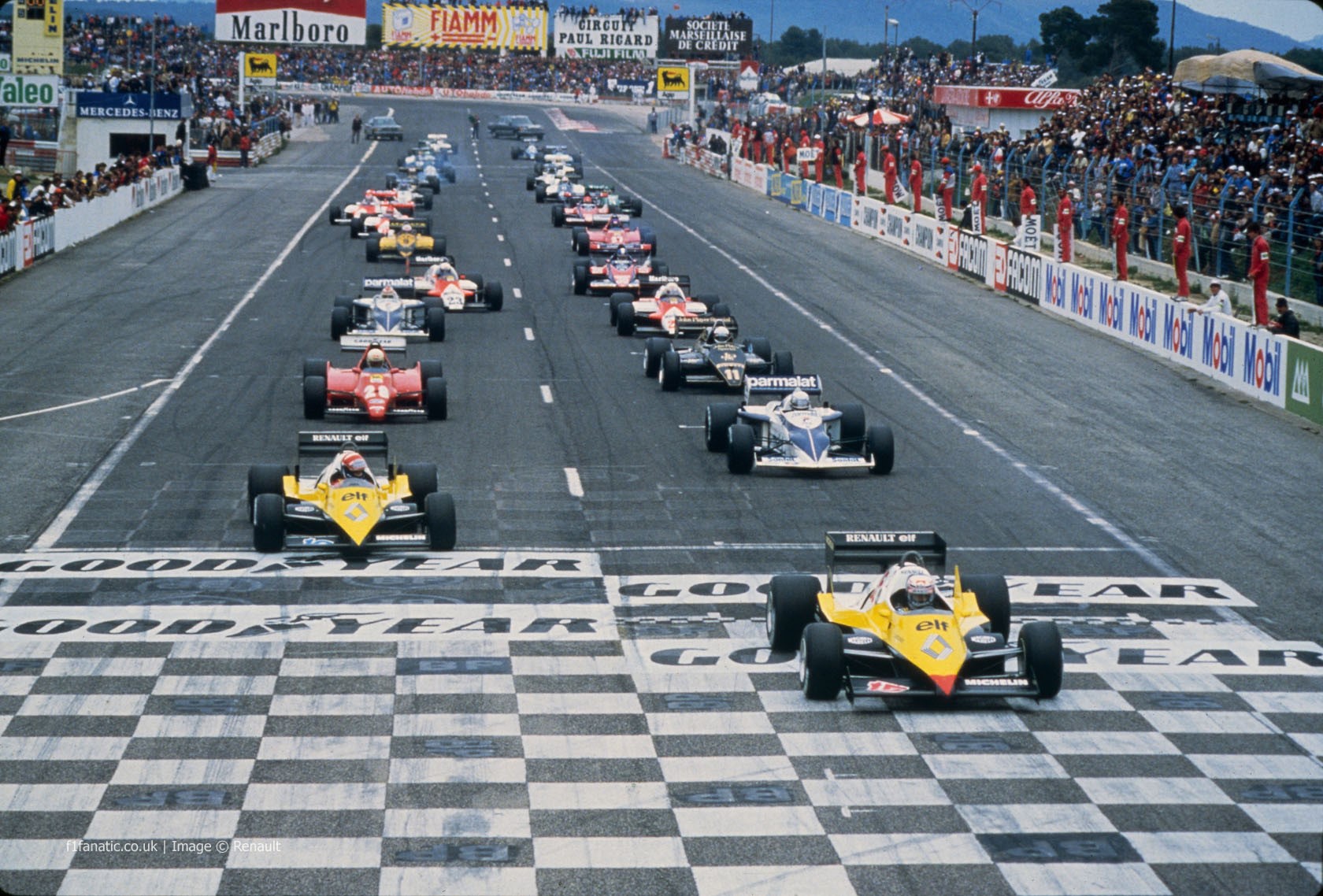
Start at Paul Ricard in 1983.
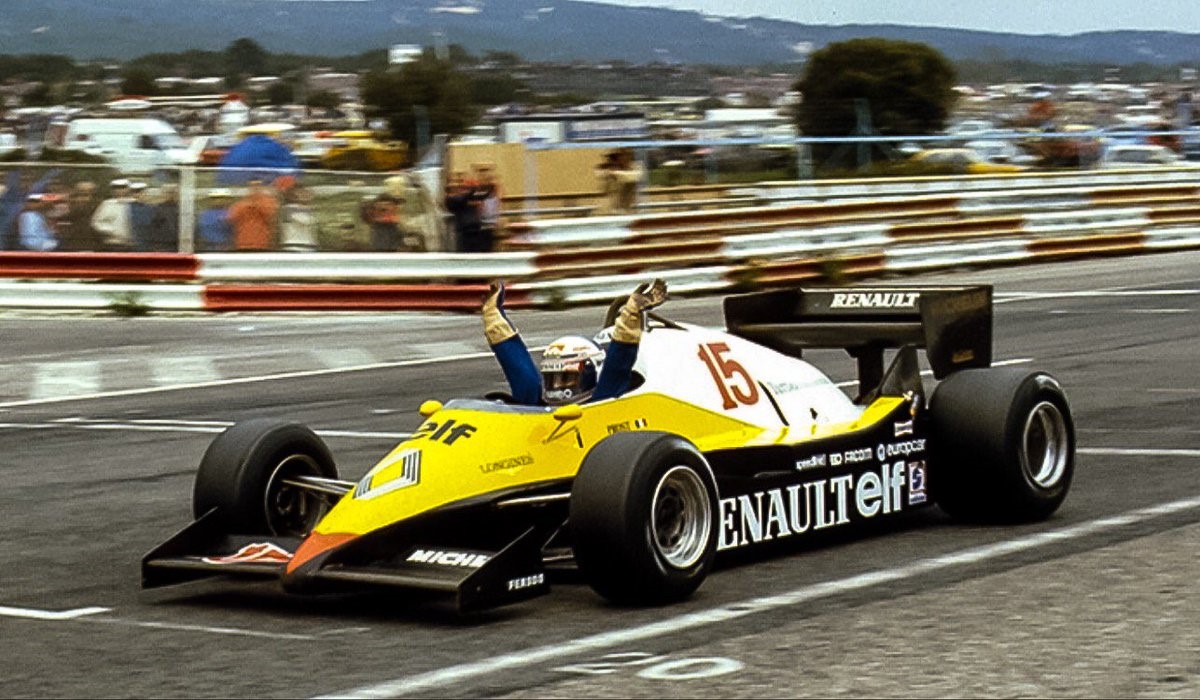
Renault’s Alain Prost won the French GP at Paul Ricard in 1983, from Brabham’s Nelson Piquet and his Renault team-mate Eddie Cheever. By Stuart Dent.
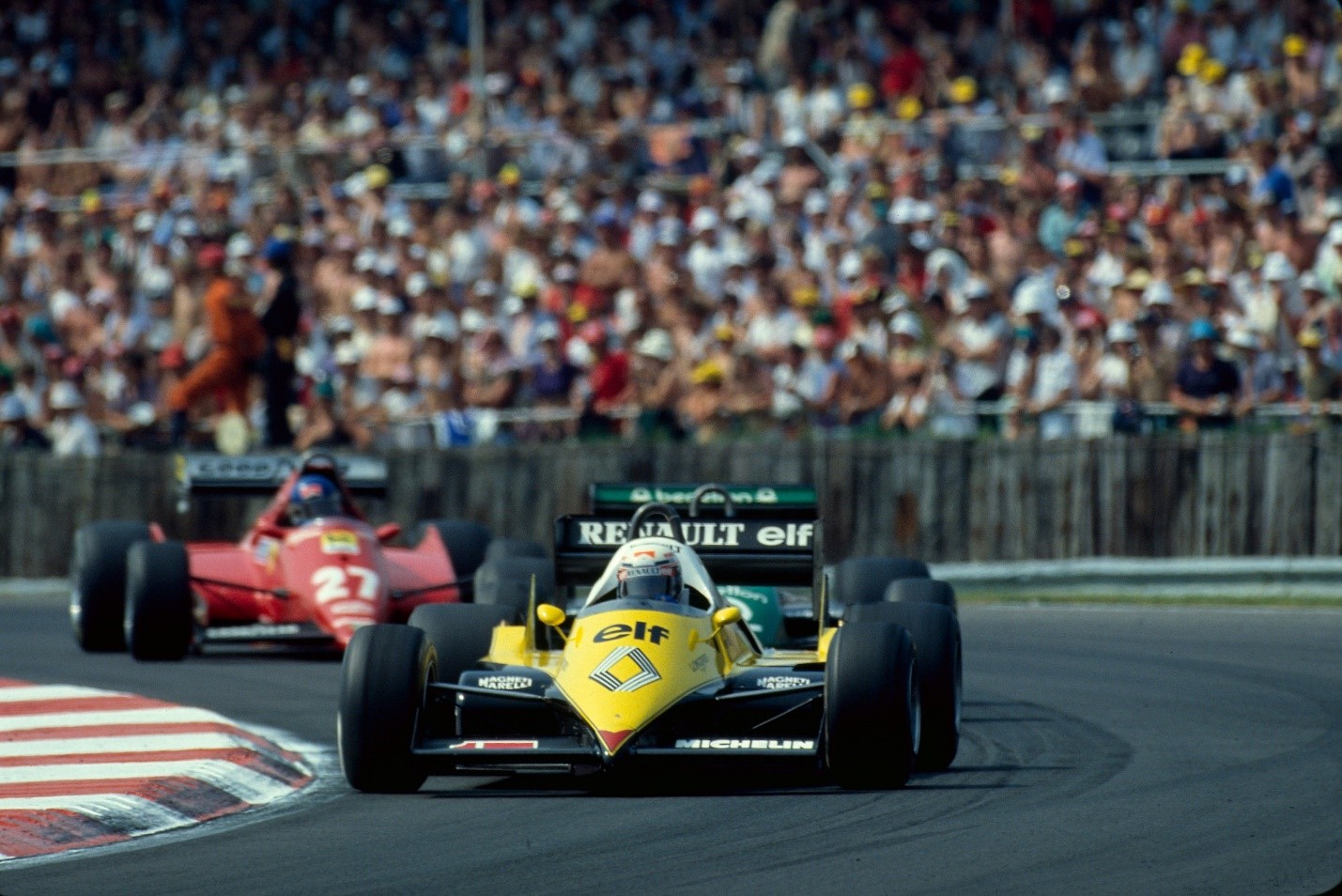
Renault RE 40 and Alain Prost in 1983.
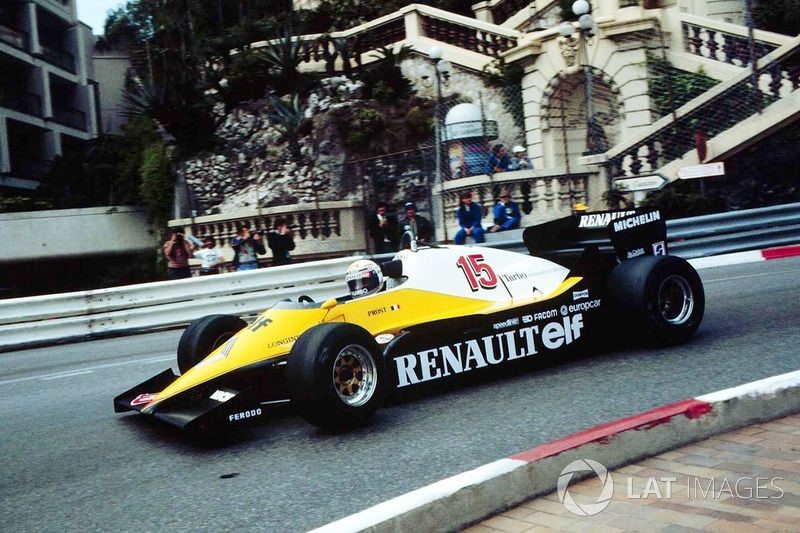
Alain Prost, Renault RE40, 1983 Monaco GP, Monte Carlo.
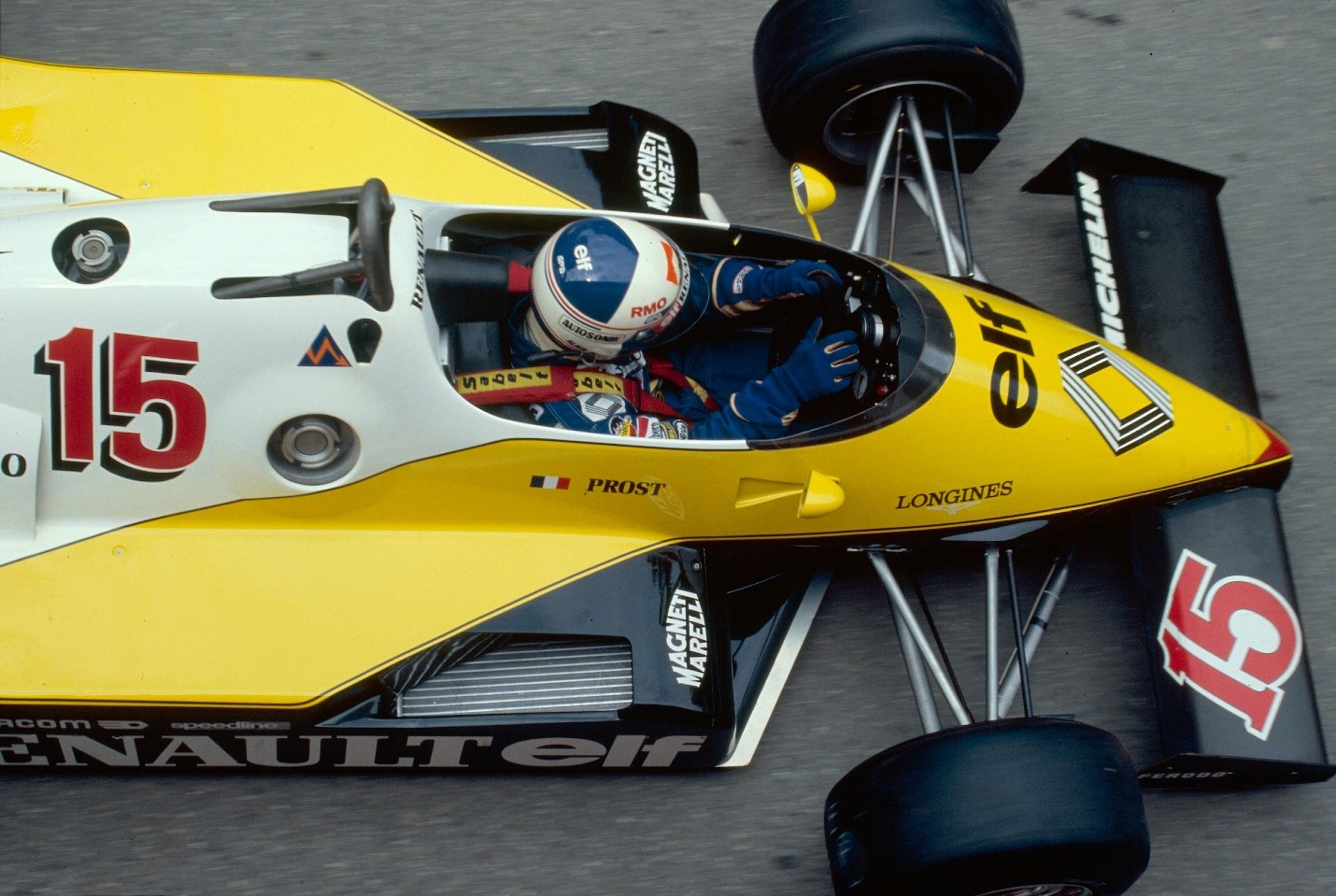
Alain Prost, Renault RE40, 1983 Monaco GP, Monte Carlo.
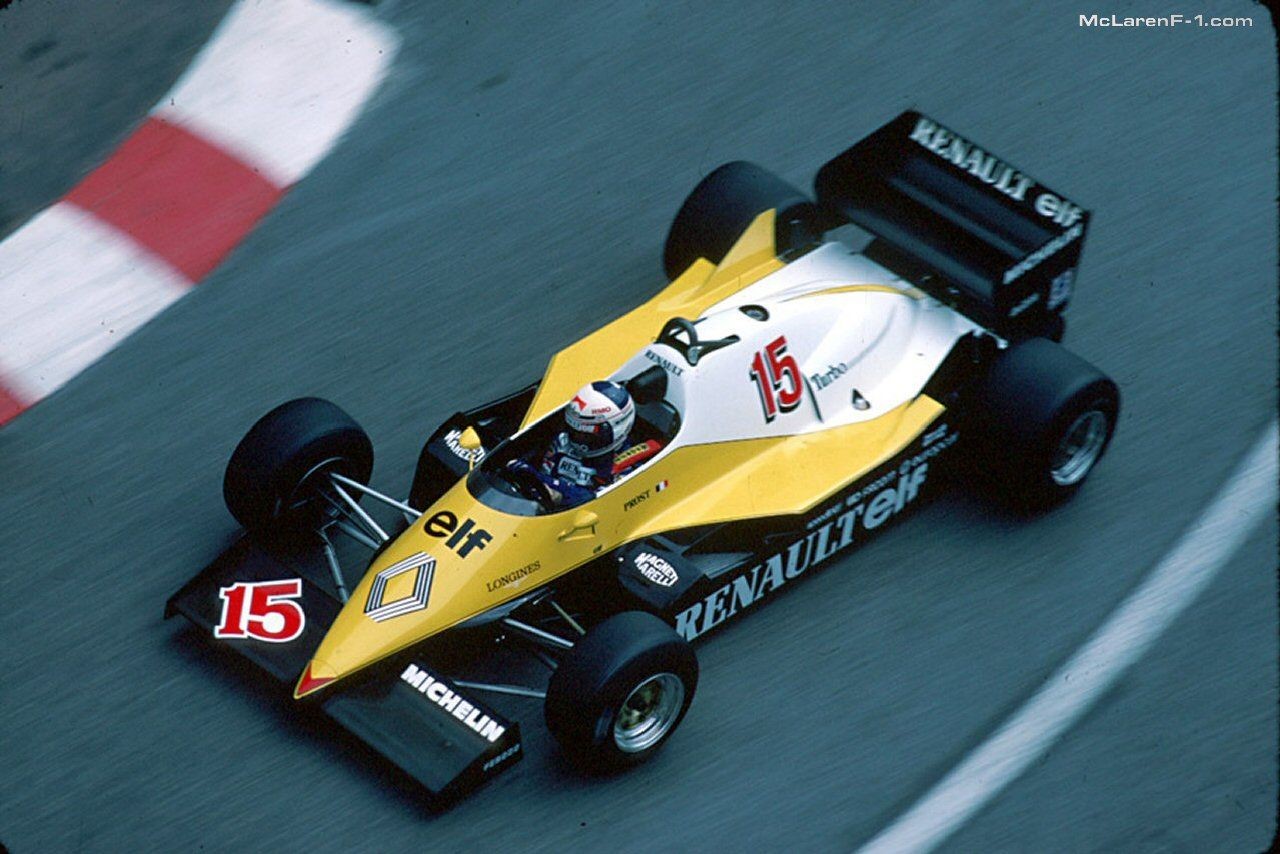
Alain Prost and his Renault in 1983. McLaren photo gallery.
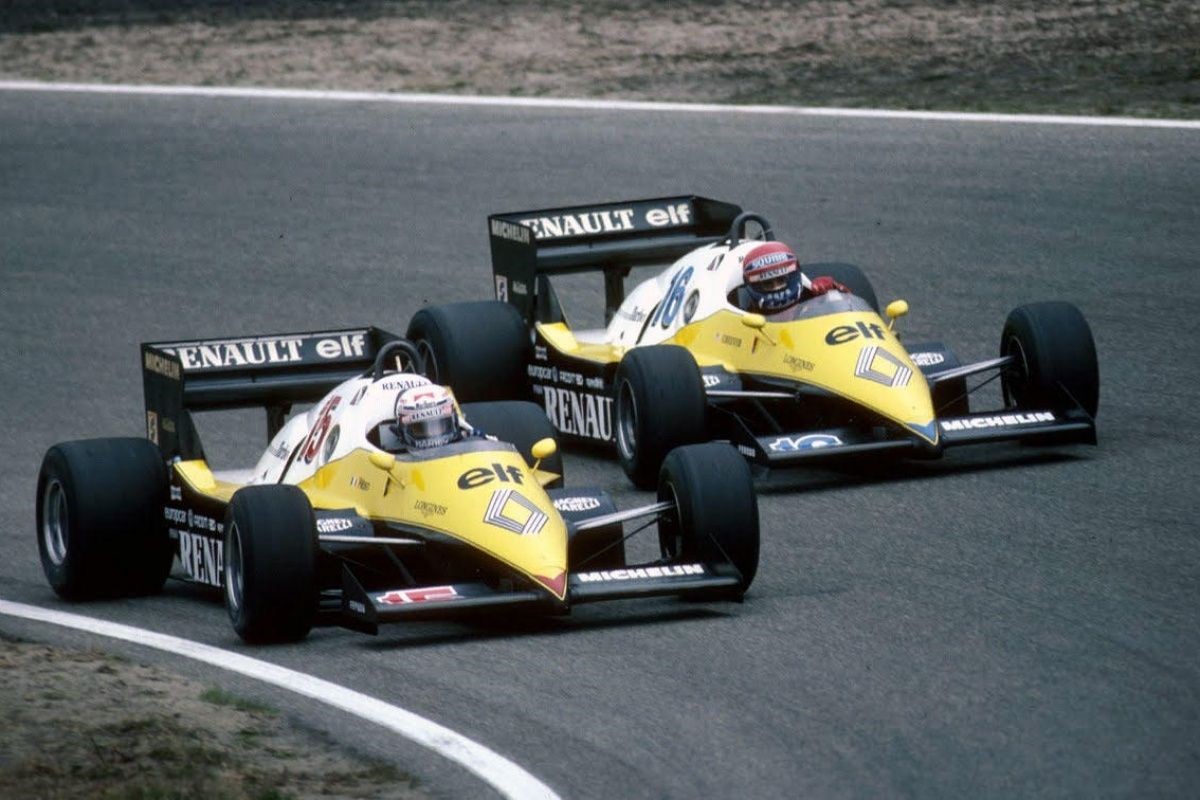
1983 Renault RE40. 15 Alain Prost and 16 Eddie Cheever.
Following Prost's complaints on Renault's development progress, the French company fired Prost only two days after the end of the 1983 season.
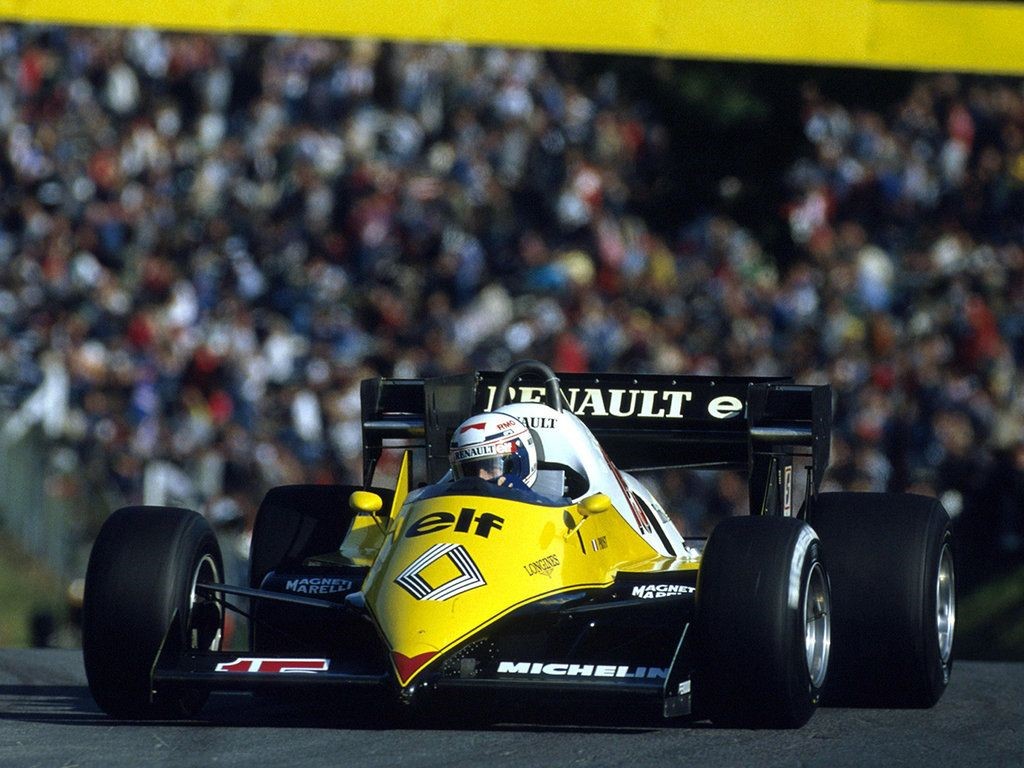
1983 Alain Prost, Renault RE 40, Renault-Gordini EF1 1.5 V6. By Richard Black.
Renault picked up two new driver for the 1984 season: former Ferrari driver Patrick Tambay and former Toleman driver Derek Warwick. Renault's car lacked pace compared to other cars and the Renault-supplied Lotus and Ligier teams was significantly faster than the works Renault team. They finished the season without any wins. The team entered three cars in 1985, the first team to do so. The third car, driven by Francois Hesnault, failed to finish its debut race at Nürburgring, Germany. Financial difficulties struck Renault in 1985 and Renault retired their works team at the end of the 1985 season. They later withdrew from its role as engine supplier at the end of the 1986 season.
Renault returned in 1989 to supply teams Williams and, once again, supplied Ligier with V10- engines in 1992. Renault's partner company, Mecachrome, managed the supply. Despite officially retiring from the sport in 1996, Williams would proceed to use Renault engines, dubbed as Mecachrome engines and Benetton snatched Ligier's Renault supply and named the engines 'Playlife', after a brand of clothes owned by the Benetton family.
Renault's true second era began in 2000, when they bought the Benetton team from the Benetton family. They continued to race under the Benetton name and livery until 2002, when the team was named Renault F1. The car sported a blue and yellow Mild Seven and Elf livery. They entered with drivers Jenson Button and Jarno Trulli and finished 4th in the constructor's championship with only 23 points, almost 200 points behind leading team Ferrari. Button was replaced by Fernando Alonso in 2003, who would grab this Renault incarnation's first win in Hungary. The car used that season, the R23, had several innovative features, notably sporting a 111 degree V10 engine, which, despite being very heavy and unreliable, gave the car a lower center of gravity and a better handling compared to other cars of that season. In 2004, Renault switched to a more conventional engine to increase reliability and lower weight. The team managed five podiums and one win and contended for second place in the constructor's championship for the major part of the season, but an ongoing dispute with Trulli lead to him leaving in favour of Toyota and Renault replaced him with former champion Jacques Villeneuve for the last three races of the season. Villeneuve, who had not raced in F1 for several years, was unable to get up to pace in time to save Renault's chances for second place and the team was overtaken by BAR-Honda. Giancarlo Fisichella replaced Trulli and Villeneuve for 2005.
2005 was painted in Renault's colours, as they managed 8 wins and 10 podiums and claimed the constructor's title and Alonso took his first driver's title. Thus, Renault ended the reign of Ferrari and Michael Schumacher. The only serious challenger that year was McLaren, but they suffered from poor reliability that season. Part of their success is believed to be due to the innovative tuned mass damper, which reduced the effect of kerbs and kept the nose stable through corners, significantly improving the RS25's handling. In 2006, Renault introduced another new innovation: a gearbox made out of titanium, in order to reduce weight. The mass dampers they used during the 2005 season and the first half of the 2006 season were banned and Renault lost a big advantage due to this change. Nevertheless, Renault and Alonso managed to defend their respective titles, only five point ahead of rival team Ferrari. In 2007, Renault lost Alonso to McLaren, who was replaced by Finn Heikki Kovalainen, while Fisichella was retained. Renault fell back to 3rd place in the championship this season, more than 150 point behind Ferrari. The same season, Renault was accused by the FIA of being in possession of data on several McLaren components, which McLaren supposedly had developed using stolen data from Ferrari. Renault was found guilty, but was not penalised.
Alonso returned to Renault in 2008, partnered by Nelson Piquet jr. Renault suffered from an unreliable package the whole season and they finished 4th that season. In 2009 Renault was accused by the FIA of race fixing at the 2008 Singapore grand prix, as team principals Flavio Briatore and Pat Symonds had given Piquet orders to stage a crash and bring out a safety car, which contributed to team mate Alonso's win. The controversy lead to the ban of Briatore and Pat Symonds from actively participating in F1.
In 2009, Piquet was replaced mid-season by Romain Grosjean, though only all 26 of Renault's points were scored by Alonso. Renault finished in 8th place. In 2010, Renault sold 75% of the ownership to Genii capital and raced with Vitaly Petrov and Robert Kubica. Alonso left Renault in favour of Ferrari. The season was an overall improvement compared to the 2009 season, but the team was still outscored by Renault-supplied Red Bull. That season, Red Bull took their first out of four consecutive titles. In late 2010, the Renault sold its last shares to Genii Capital and the team was renamed to Lotus Renault, with a new black and gold livery similar to old Lotus F1's John Player Special livery for the 2011 season. Renault continued to supply Lotus until the end of the 2014 season, when the team decided to switch to the much more powerful and reliable Mercedes units.
Since the withdrawal of Renault's works team in 2010, Red Bull has basically served as Renault's works team. The partnership involves several sponsors linked to Renault, such as oil brand Total and luxury car brand Infiniti, a subsidiary of the Renault-Nissan group. Lead by German driver Sebastian Vettel, Red Bull has won four titles in a row between 2010 and 2013. However, the hybrid era, which began in 2014, has proven difficult for Renault, as the units supplied by Renault has proven inferior in terms of power and reliability compared to dominant Mercedes. Red Bull finished 2nd in 2014 and will finish 4th in 2015. Cracks in the Red Bull-Renault partnership has emerged and it remains unsure if Renault will supply Red Bull for the next season.
Renault has apparently sent in a letter of intent to the FIA regarding a purchase of the financially troubled Lotus team. The team has had a hard time to cover costs this season and has almost been unable to race at several grand prix. As is stands today, it is unclear whether Renault will fulfill this purchase or not. If they do, Bernie Ecclestone, head of the Formula One Group, has stated that Renault will be made a historic team and as such they will enjoy benefits like increased prize money. Unconfirmed rumors claim that Renault consider leaving the sport altogether.
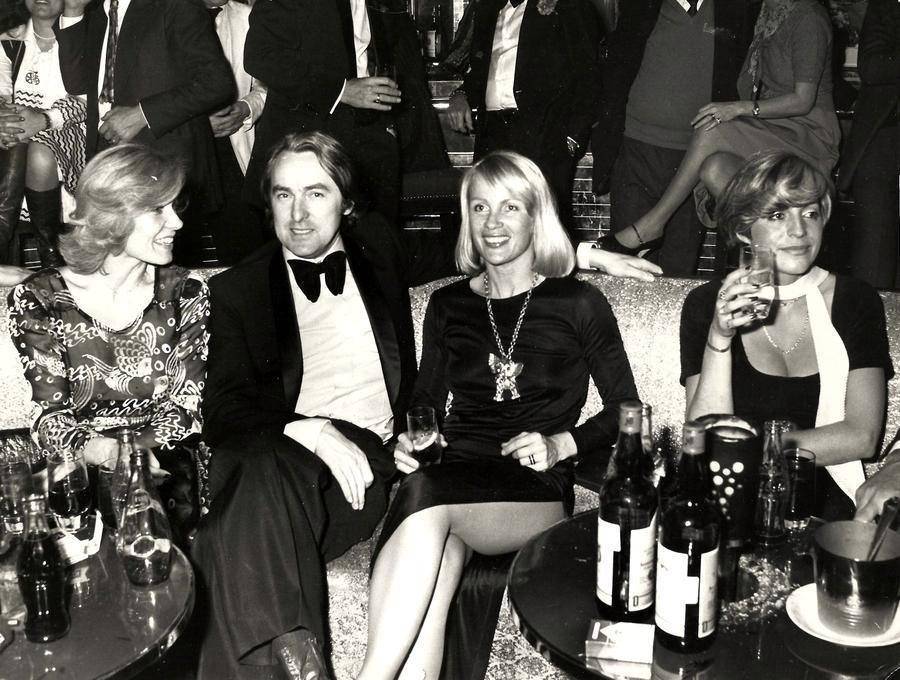
Gerard Larousse (former Renault team manager), Marie Claude Beaumont and Françoise Conconi.
Renault F1 Team - History: the history of today’s Renault team is like peeling back the layers of an onion: its original incarnation was Toleman Motorsport, which entered Formula One in 1981 having taking part in British Formula Ford 2000, British Formula Two and the European Formula 2 Championship.
The Rory Byrne-designed Toleman TG181 was an overweight and underpowered car and drivers Brian Henton and Derek Warwick failed to qualify in their first nine outings. Henton finally made it onto the grid at Monza and finished in tenth; after that Toleman went on to make 57 Grand Prix starts although most ended in retirement. The team’s biggest claim to fame was handing then-British Formula 3 champion Ayrton Senna his first taste of Formula One in 1984 – he handsomely repaid them with three podium positions.
In 1985 Toleman acquired major sponsorship from the Benetton clothing company, previous sponsors of Tyrrell and Alfa Romeo. The team was duly renamed, the flamboyant Flavio Briatore taking over as manager from 1990 with Tom Walkinshaw and Ross Brawn brought in to oversee engineering operations. Rocco Benetton took over as CEO in 1998 and replaced Briatore with Prodrive boss David Richards, before becoming team principal himself.
Teo Fabi, Gerhard Berger, Thierry Boutsen and Johnny Herbert were among the initial drivers to race for Benetton, but the team will be forever linked to the rise of Michael Schumacher. Having made his maiden Formula One appearance with Jordan Grand Prix at Spa in 1991, Schumacher was immediately snapped up by the astute Briatore: their partnership resulted in two world championships in 1994 and 1995, the latter coupled with constructors success for Benetton.
Things were never quite the same once Schumacher moved on to Ferrari in 1996 taking with him Brawn, Byrne and others. The team ended its long-time association with engine partners Ford and formed a new alliance with Renault, but the French manufacturer soon pulled out of Formula One leaving the team resorting to rebadged Mecachrome units instead. However, when Renault had a rethink about their Formula One strategy and wanted a works team it was Benetton that proved their natural purchase for an estimated $120 million in 2001.
Renault were soon contending again for the championship. They finally achieved back-to-back constructors’ titles in 2005 and 2006 with driver Fernando Alonso clinching two world titles in the process. But Renault’s business strategy changed again, opting to become an engine supplier rather than team owner: the squad was sold to Genii Capital which renamed it Lotus F1 in 2012, while Renault engines powered Red Bull Racing to four consecutive constructor titles between 2010 and 2013.
A souring of relations between Renault and Red Bull in 2015 coincided with Lotus hitting serious financial problems, so Renault decided to reacquire their old works team with Frederic Vasseur as principal, Bob Bell as technical chief and an all-new driver line-up consisting of Kevin Magnussen and Jolyon Palmer.
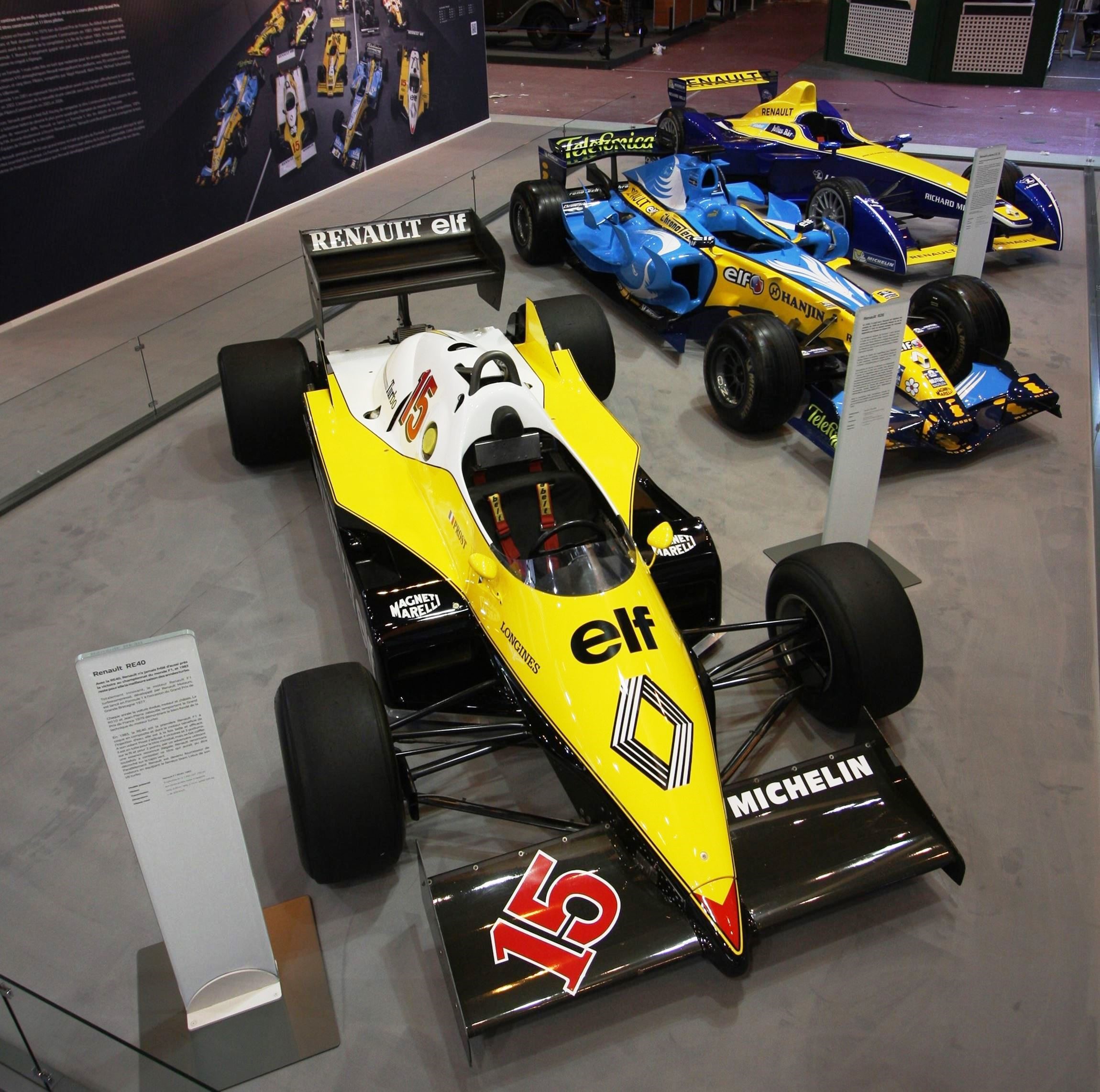
2016 Renault Sport Formula One Team 19.
After a tough 2016, the team was still aiming high for its second season and secured the signature of Nico Hulkenberg for 2017.
In 2017 Jolyon Palmer and Nico Hulkenberg would be driving for the French manufacturer, disappointing results saw Palmer replaced at the US Grand Prix by Carlos Sainz and Renault could only manage 6th in the championship.
2018 saw Renault finish in the coveted 4th spot, best of the rest and close to 30 points ahead of Haas in 5th. However Renault will be aiming to go better in 2019 as they will have Daniel Ricciardo, secured from Red Bull in a shock move, alongside Nico Hulkenberg.
Renault - Year by Year.
2019
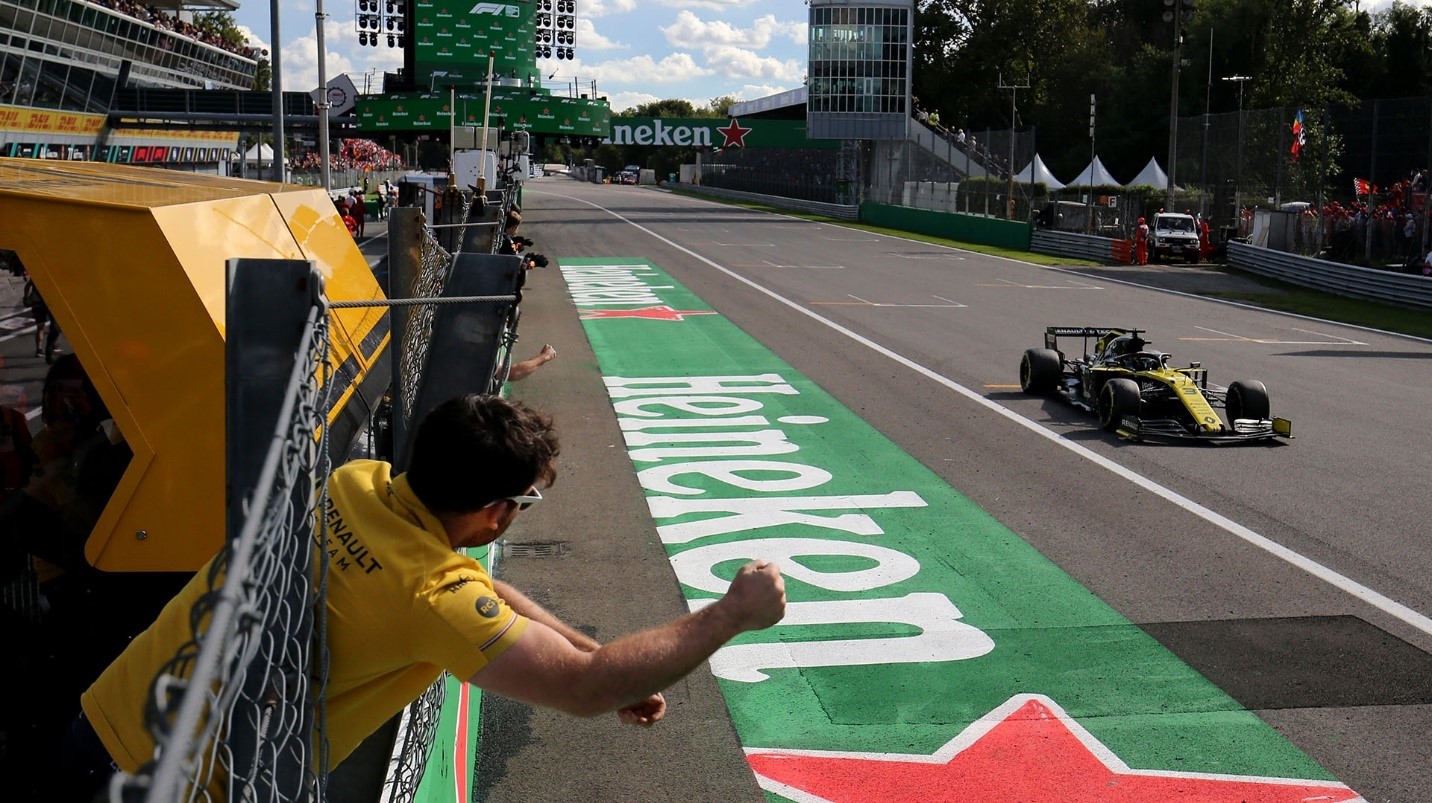
Progress up the championship order is halted, ironically by new Renault customers McLaren, who demote them to fifth in the standings, despite Daniel Ricciardo securing their best result to date with P4 in Italy.
2018
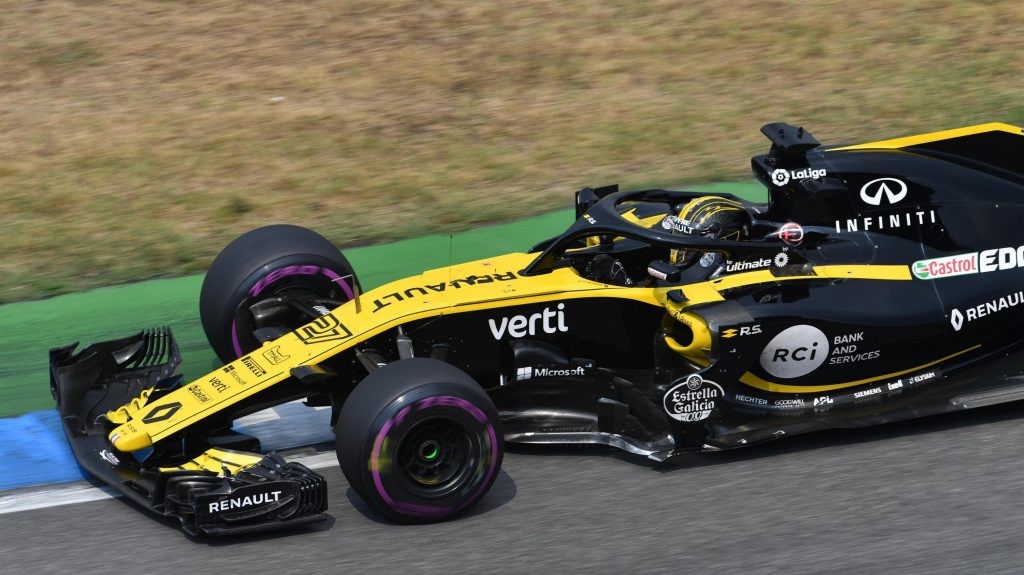
Rise up the grid continues apace, as the team see off Haas to become ‘best of the rest’ behind the top three teams. Not quite podium contenders yet – fifth places in Azerbaijan and Germany are their best results – but their obvious potential lures Daniel Ricciardo away from Red Bull for 2019, replacing Carlos Sainz.
2017
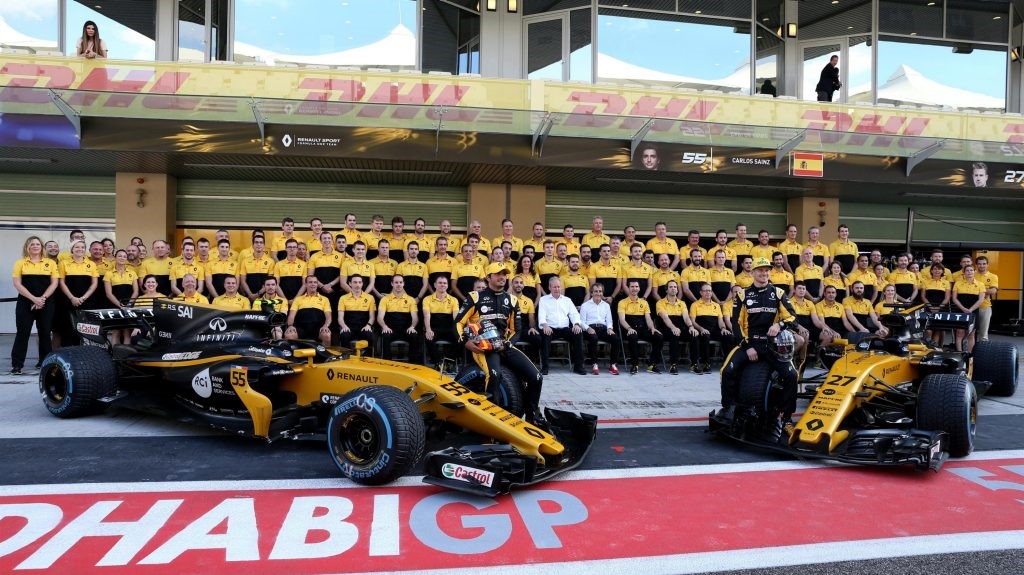
Huge strides are made with the team’s first car designed around their own powerplant, resulting in a sevenfold increase in points scored and a four-place leap in the standings. Jolyon Palmer replaced as Nico Hulkenberg’s team mate mid-season, with Carlos Sainz joining to form one of the grid’s strongest driver line-ups.
2016

A tough year of transition, as the R.S.16 car - originally designed around a Mercedes engine - proves far from competitive in the hands of former McLaren racer Kevin Magnussen and former Lotus tester Jolyon Palmer. Score on just three occasions, with a best of seventh for Magnussen in Russia and finish a lowly ninth in the final standings.
2015
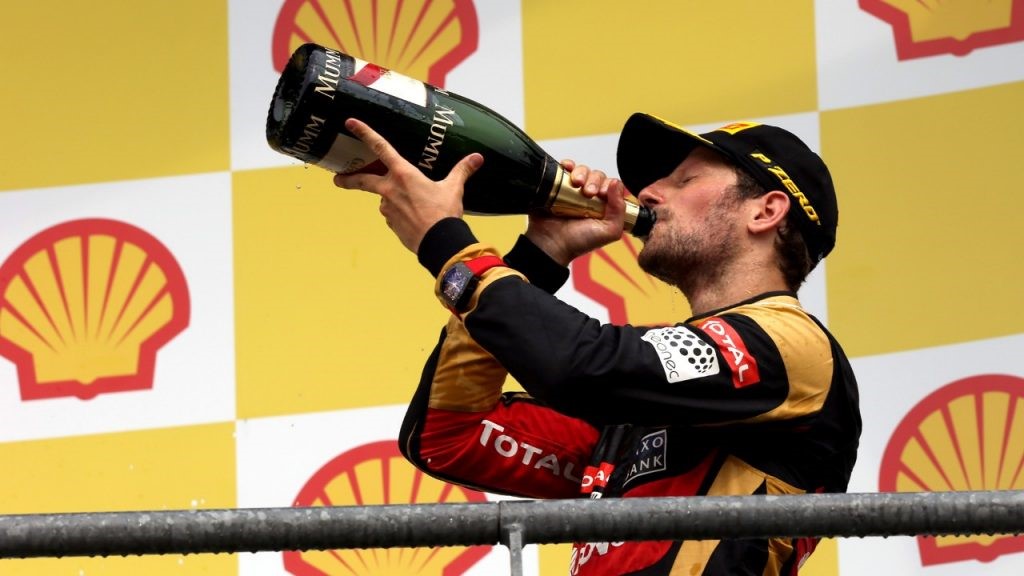
Final season under Lotus name before Renault takeover. Form much improved over 2014, with the Mercedes-powered E23 accumulating 78 points in the hands of Grosjean and Maldonado, the former’s fine third in Belgium being the team’s best result.
2014
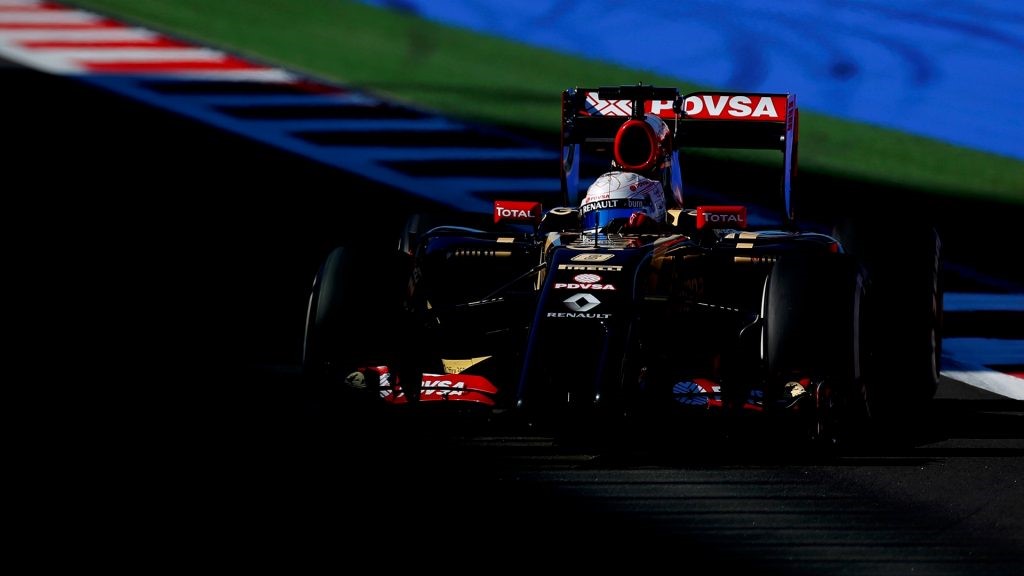
Plummet down the order to eighth overall as team struggle to make E22 and its hybrid Renault power unit reliable or competitive. Grosjean scores eight points and Maldonado just two, with the former's eighth places in Spain and Monaco their best results of the year.
2013

Burst out of the gates with Raikkonen winning in Australia in the quick and tyre-friendly E21. Car proves a good match for most circuits and conditions, helping Raikkonen and Grosjean to a further 13 podiums between them, taking team to a strong fourth place overall.
2012
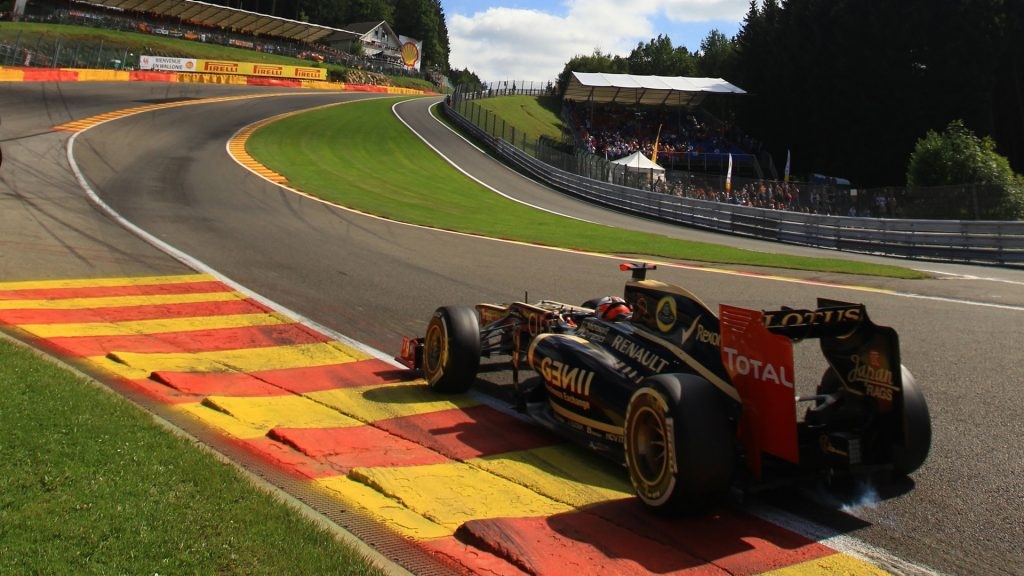
Team name officially changes to Lotus from Renault (formerly Benetton, 1986-2001). F1 returnee Kimi Raikkonen and Romain Grosjean score several podiums over course of season and are consistently on leading pace, but team has to wait until Abu Dhabi for sole Raikkonen-inspired victory.
Renault’s F1 team is based at Enstone in Oxfordshire, in the United Kingdom.
Team history and statistics: Renault. By Jan Sergeant. Jun 14, 2020.
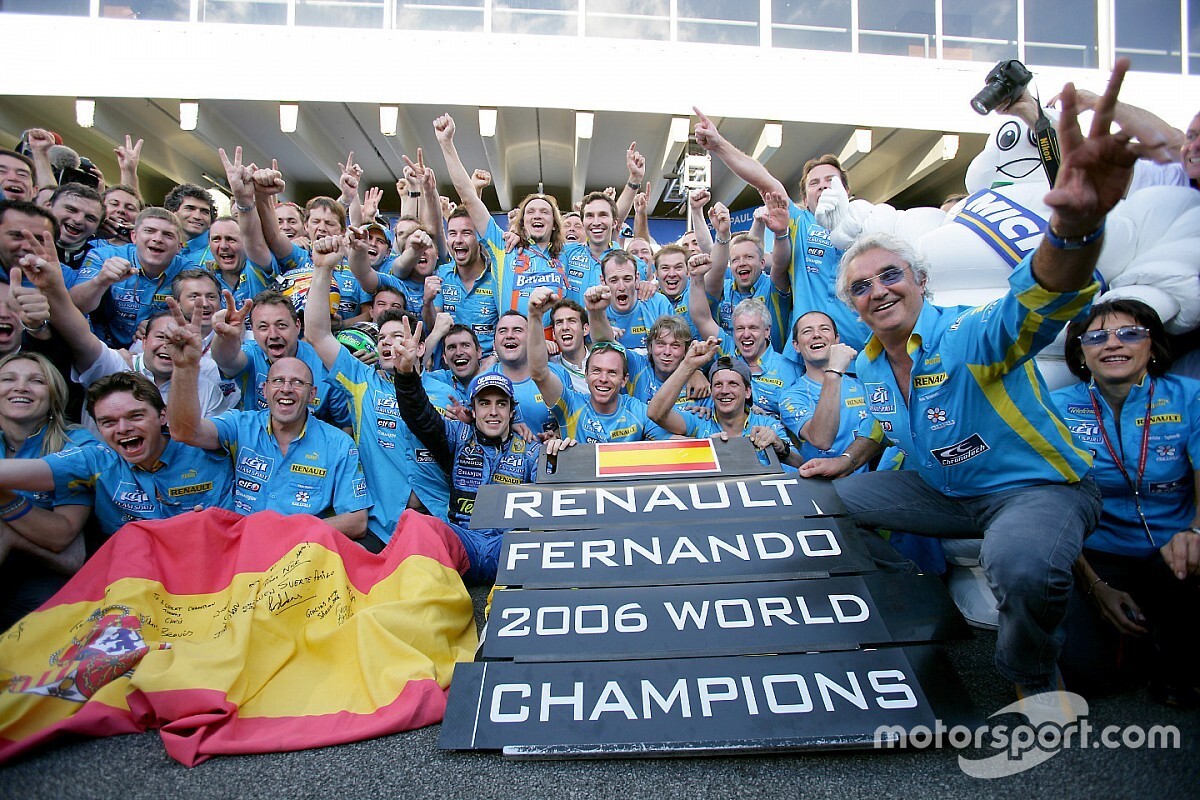
With Renault announcing that it remains committed to Formula 1, it can now focus its attention on rebuilding the team and rebounding from an underwhelming 2019 season.
Here we take a look at Renault’s F1 history through its records.
Races Started: 383
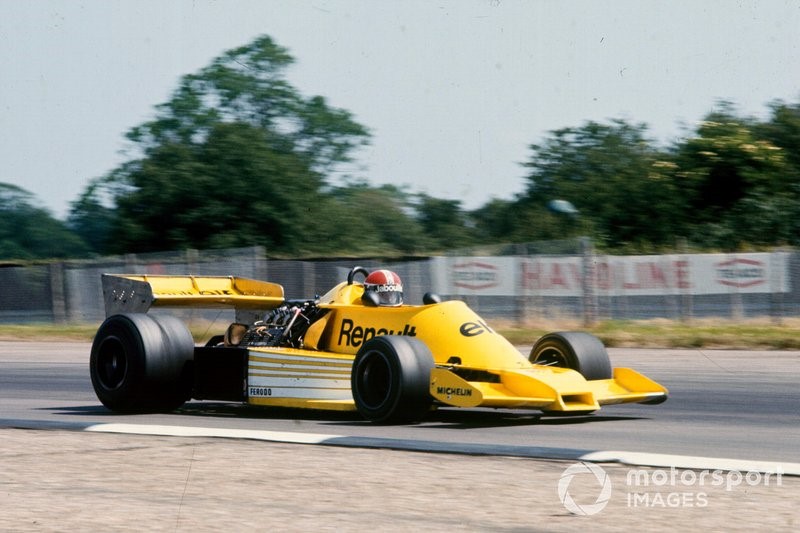
Jean-Pierre Jabouille, Renault RS01. Photo by Motorsport Images.
Renault has started 383 grands prix (which is only 10 more than Sauber), putting it seventh in the all-time list of teams/constructors. The current record holder of that is Ferrari with 991 race starts.
Wins: 35
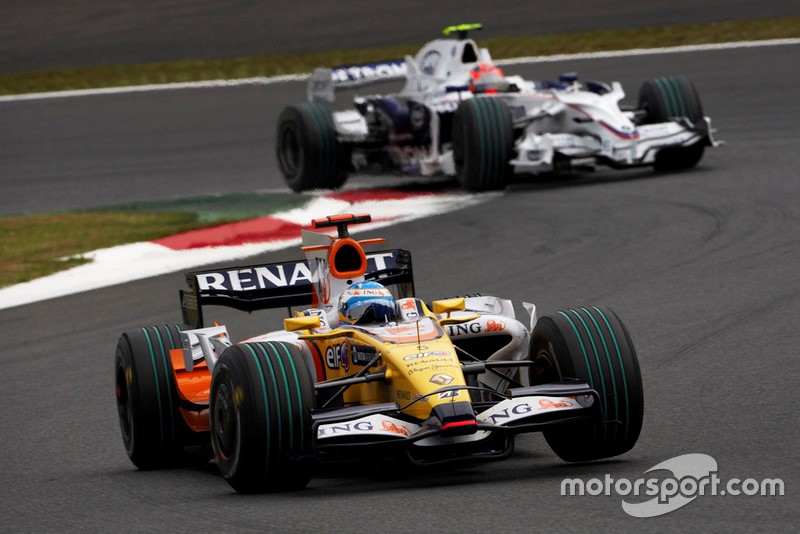
Fernando Alonso, Renault R28 leads Robert Kubica, BMW Sauber F1.08. Photo by Steve Etherington / Motorsport Images.
Since that first start in 1977, Renault has won 35 grands prix. That puts it in seventh place in the all-time list of race winners. Current rival Red Bull is in sixth with 62 race wins. Ferrari is again the top team in wins with 238.
Renault’s last race win came at the 2008 Japanese Grand Prix when Alonso started from fourth on the grid. The race lead changed 10 times that day and we had six different leaders, but on lap 53 Alonso took the lead from teammate Nelson Piquet Jr. in his Renault R28 and went on to triumph.
Podium places: 100

The Renault team including Jean Sage, Renault Team Chief, celebrate Jean Pierre Jabouille's first win and their first Grand Prix victory. Photo by Sutton Images.
A century is a nice round number for Renault’s total of podium places in F1. In last year’s Italian Grand Prix, Daniel Ricciardo wasn’t that far away from scoring its 101st when he finished fourth, which was Renault’s highlight of 2019.
With a tally of 100, it is ranked ninth on the all-time podium scorers, only two less than Benetton’s 102 – with the history of the two teams unified by Enstone.
Renault’s first podium came in 1979 at its home race in the French Grand Prix when it was held at Dijon. Jean-Pierre Jabouille had qualified his Renault RS10 on pole position but at the start he lost the lead to the Ferrari of Gilles Villeneuve. On lap 46 Jabouille took the lead over from Villeneuve to win his and Renault’s first grand prix. This race is perhaps best remembered though for the battle for second place between Villeneuve and Rene Arnoux, who was in the second Renault. At the chequered flag Arnoux finished 0.24s behind Villeneuve.
Pole positions: 51
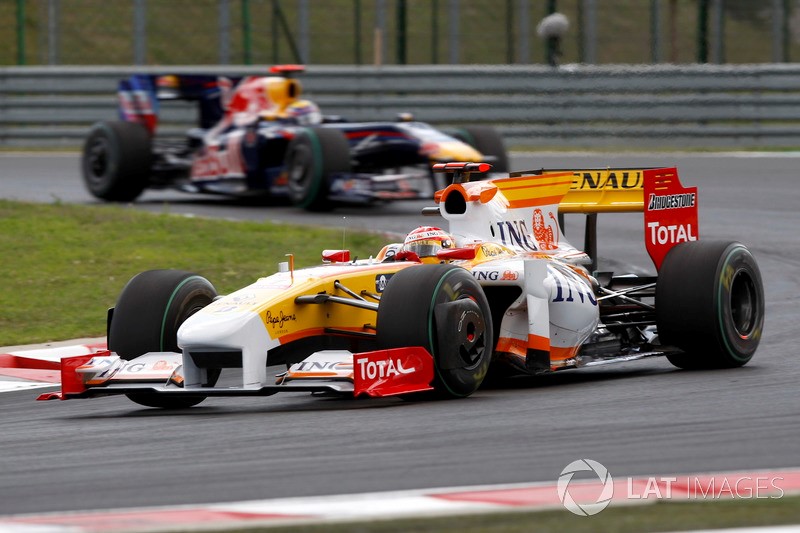
Fernando Alonso, Renault F1 Team R29 leads Mark Webber, Red Bull Racing RB5. Photo by: Andrew Ferraro / Motorsport Images.
Since 1977, Renault has scored 51 pole positions in F1. That’s good enough for seventh place in the current all-time list and is just 11 less than Red Bull.
Renault’s last pole position was at the 2009 Hungarian Grand Prix, with Fernando Alonso in the R29. But the race was a different story. Alonso made a good start, leading 11 laps, but a bad first stop and a problem with the fuel pump caused a retirement when he was running in 15th place.
Fastest laps: 31
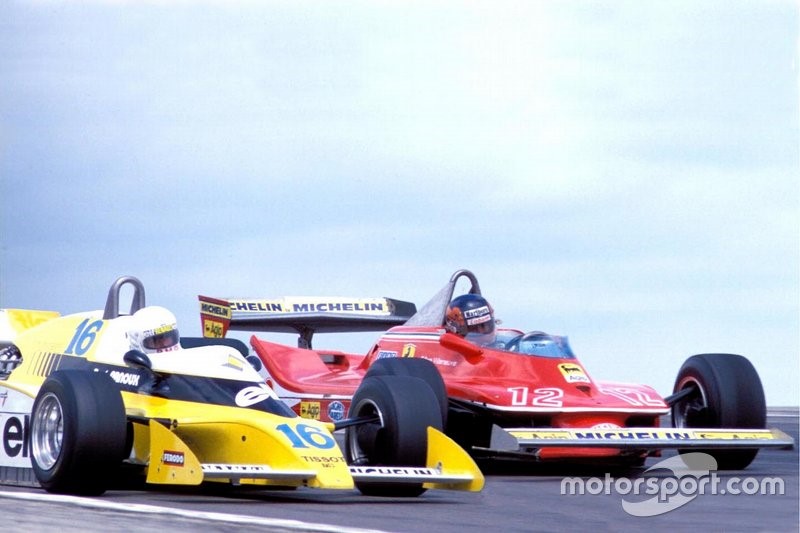
Gilles Villeneuve, Ferrari 312T4, René Arnoux, Renault RS10. Photo by Ercole Colombo.
With 31 fastest laps. Renault is ranked ninth in the all-time record, which means the outfit is in the top 10 of all the main achievements.
The first time a Renault driver set the fastest lap in a race was when it won that 1979 French Grand Prix.
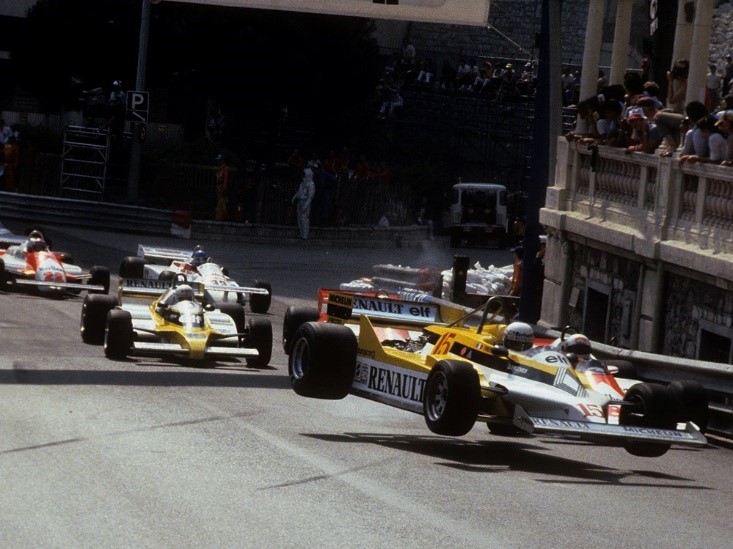
1981, pile up in Monaco GP.
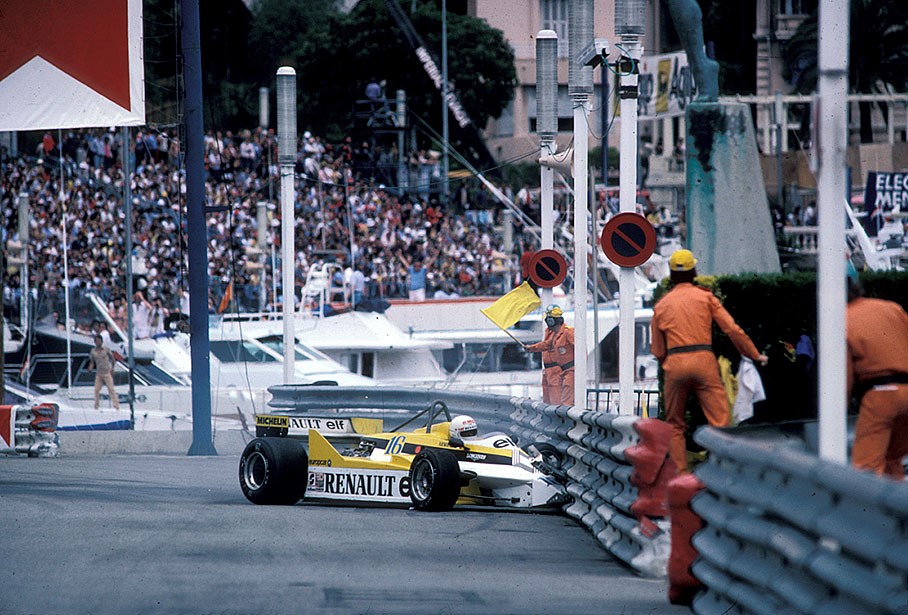
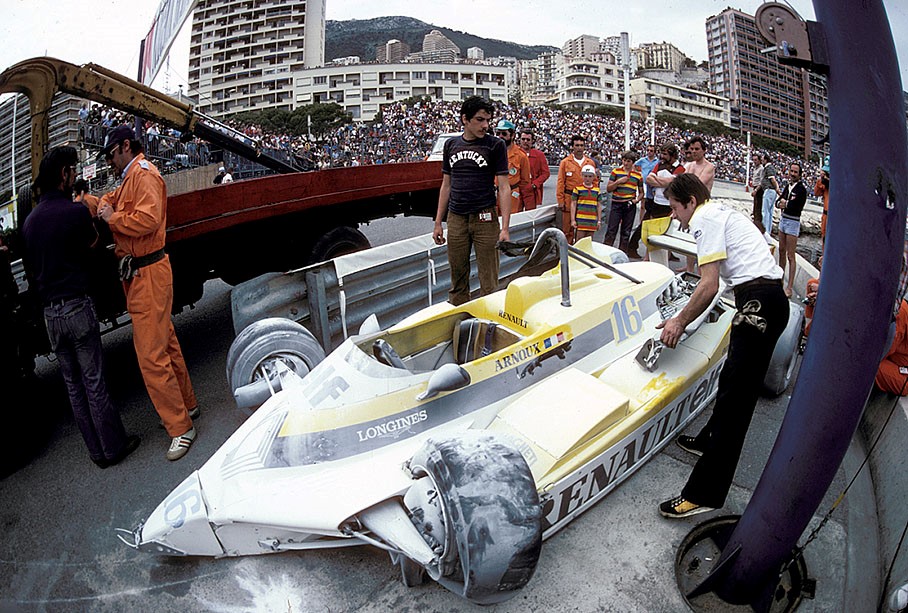
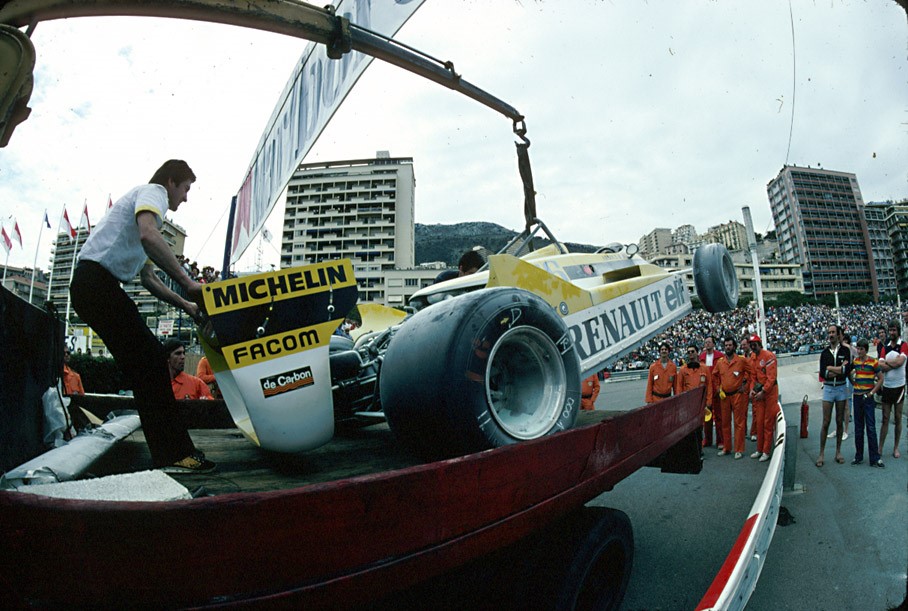
Arnoux’s accident at Monaco in 1981.
But the fastest lap was for Arnoux rather than race winner Jabouille.
Hat tricks: 11
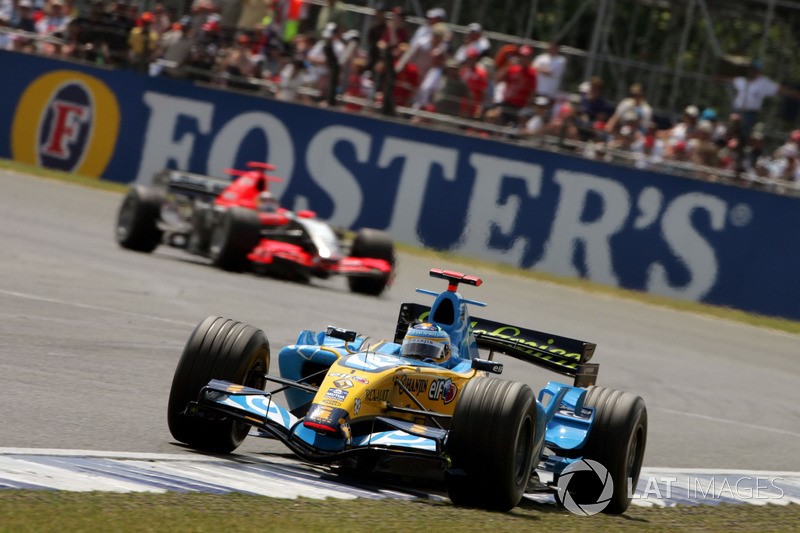
Fernando Alonso, Renault F1 Team R26. Photo by Sutton Images.
A perfect score for a team in F1 can be viewed as a double (a victory and second place), but there is also the hat-trick achievement of win, pole and fastest lap. Renault has scored 11 hat tricks up until now. The last time was at the 2006 British Grand Prix with Alonso at the wheel.
Fernando Alonso scored Renault’s 11th Hat trick at Silverstone in 2006.
Renault F1 statistics:
|
Races started |
383 |
|
Wins |
35 |
|
Pole positions |
51 |
|
Fastest laps |
31 |
|
Hat tricks |
11 |
|
Grand chelems |
3 |
|
Races in podium |
88 |
|
Podium places |
100 |
|
Front row |
69 |
|
Front row places |
91 |
|
Raced laps |
36497 |
|
Raced km |
178118 |
|
Races led |
88 |
|
Led laps |
2515 |
|
Led km |
12154 |
|
Points |
1596 |
|
Points (drivers) |
1596 |
|
Championships |
2 |
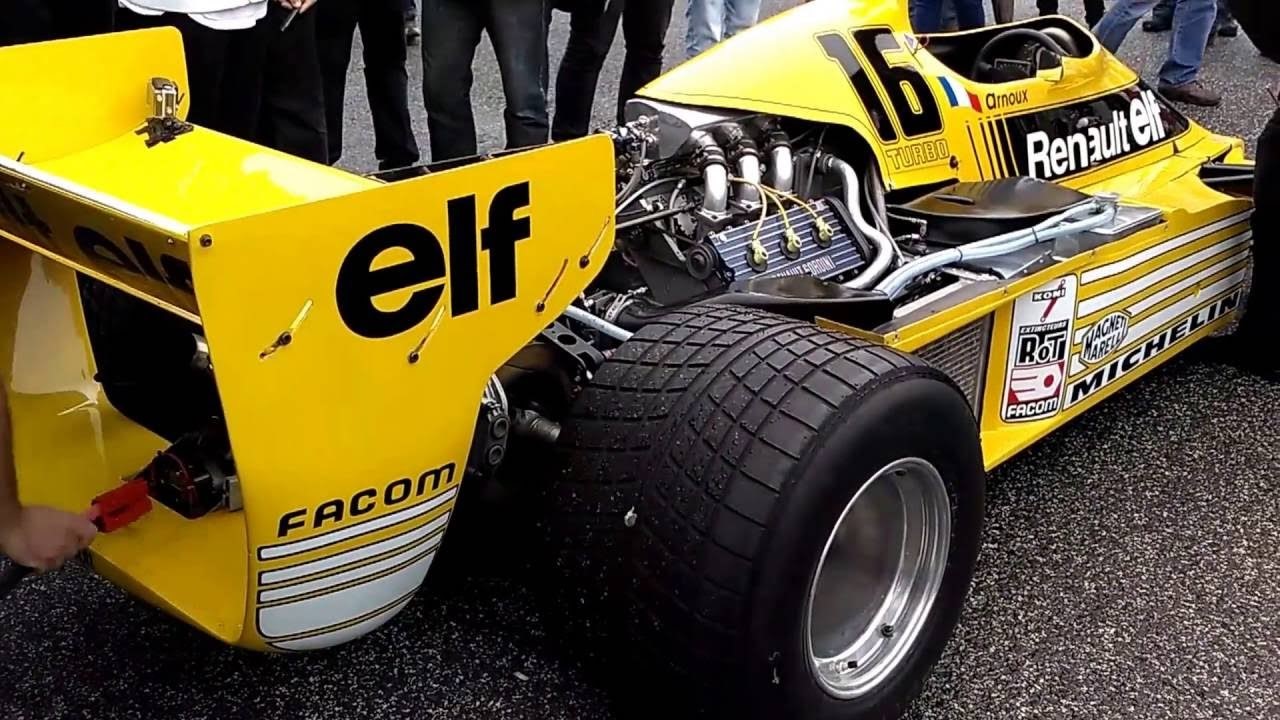
Renault F1 is a Formula One racing team. It was once owned by the Renault company. In December of 2010, Renault sold their remaining part of the Formula One team. Renault has a long history in F1. Ferenc Szisz won the first French Grand Prix at the wheel of a Renault. Since then Renault has competed in Formula One as an engine supplier and as a builder from the late 1970s to the present day, with many breaks. Renault introduced the turbo engine to Formula One when they debuted their first car, the Renault RS01 at Silverstone in 1977. Although the Renault team won races and competed for world titles, it was as a supplier of engines to the Benetton and Williams teams in the 1990s that Renault first tasted world championship success. Renault Engines powered drivers such as Nigel Mansell, Damon Hill, Jacques Villeneuve and Michael Schumacher to the Drivers World Championship. Renault returned to the job of being a builder in 2001 by taking over the Benetton team, which was renamed Renault in 2002. Their first championship as a builder was achieved in 2005; the same year that they won their first drivers' championship with former test driver Fernando Alonso. They repeated their success in the following year.
The teams lowest point so far was in late 2009. at the end of the 2008 season the team saw a brief return to the podium spots, with Fernando Alonso winning 2 of the last 4 races. However, Nelson Piquet Jnr, who had drove for Renault throughout the 2008 season (but was sacked from the team) told the media that the team had made him cheat in order to help Alonso win.
At the 2008 Singapore Grand Prix (the first ever Grand Prix to be held at night) Nelson Piquet Jnr lost control of his car at the outside of Turn 17, sliding across the road and smashing into a wall, throwing lots of debris across the road, meaning the Safety Car had to be called out to lead the cars through the track slowly to protect the Marshalls cleaning the road. This closed the gaps between the cars, meaning they were now racing very close together. This allowed Fernando Alonso, who was in 15th place to pass the slower less experienced drivers around him. Alonso went on to win race. After Renault fired Piquet Jnr for his poor driving in 2009, he told the FIA (the organisation that run the Formula 1 World Championship) That Flavio Briatore, the Boss of the Renault F1 Team (who had been the boss for 20 years and had cheated previously) had told him over the radio to crash the car deliberately, in order to bring the safety car out and give Alonso a better chance. Alonso was not aware of this at the time, or before to the crash.
Following a meeting of the FIA Super Council in Paris, Team Principle Flavio Briatore and Chief Engineer Pat Symmonds were found guilty. Both had to leave the team and Flavio was banned from Formula 1 for life (that band has now been lifted). In connection with the event, Renault F1's main Sponsor ING Insurance also left the team.
On 8 December, 2010, Renault announced that they had sold their remaining ownership shares in the team to Genii Capital, a private investment group. Those shares will be purchased by Lotus Cars, which is owned by Proton. Proton owns Lotus Cars. The team will be named Lotus Renault GP for 2011. They will continue to use Renault as the chassis name. The cars will use a black and gold livery (paint scheme). It will be similar to the historic John Player Special sponsorship that Lotus had in the 1970s and 1980s.
The team has raced as a French team since Renault took over Benetton in 2002. In January 2011, it was announced that they will race under a British licence in 2011. This is the first time since 1975 that there has not been a French team in Formula One.
Videos



Comments
Authorize to comment